Physical Address
304 North Cardinal St.
Dorchester Center, MA 02124
Oesophageal tumours can be broadly divided into epithelial, non-epithelial, and heterotopic, based on the cell of origin or into intraluminal, intramural, and extramural based on their location in relation to the oesophageal wall.
Epithelial neoplasms arise from the mucosa and hence can be recognised endoscopically due to mucosal irregularities. The majority of epithelial neoplasms are malignant or premalignant and these include squamous papilloma, squamous or glandular dysplasia, squamous cell carcinoma, adenocarcinoma, and neuroendocrine neoplasms. In contrast, mesenchymal neoplasms arise from the submucosa or deeper within the wall and present endoscopically with an intact normal or reactive mucosa. The majority of non-epithelial mesenchymal neoplasms are benign, such as leiomyoma, granular cell tumour, haemangioma, lipoma, glomus tumour, etc. Importantly, in a patient presenting clinically with dysphagia, non-neoplastic (tumour-like) lesions such as duplication cysts, inflammatory polyps, and heterotopia need to be considered in the differential diagnosis.
Gastrointestinal stromal tumours, primary melanoma, lymphoma, germ cell tumours, and secondary tumours (metastases) are rare in the oesophagus and will not be discussed here. The molecular pathology of oesophageal tumours will be covered in more depth in Chapter 2.
Benign oesophageal tumours and tumour-like lesions represent approximately 20% of oesophageal neoplasms found at autopsy but constitute only about 1% of all clinically symptomatic oesophageal lesions. These lesions are usually small, and bleeding due to a benign oesophageal tumour is rare and mostly related to secondary ulceration of the luminal surface.
Squamous cell papillomas are rare (less than 1% of all benign oesophageal tumours) but nevertheless represent the most common benign epithelial tumour of the oesophagus. They are most commonly located in the lower third of the oesophagus, exophytic with a warty surface, sessile or partly pedunculated, well demarcated and usually measure less than 5 mm in diameter. Related to its endoscopic/macroscopic appearance, the differential diagnosis of a verrucous squamous cell carcinoma may need to be excluded histologically. Squamous cell papillomas have been related to chronic mucosal irritation such as gastro-oesophageal reflux and possibly to human papilloma virus (HPV) infection.
Leiomyoma is a smooth muscle (e.g. mesenchymal) tumour and is the most common benign intramural oesophageal neoplasm with virtually no risk of progression to leiomyosarcoma. Leiomyomas are twice as frequent in males as in females and are usually asymptomatic. Leiomyomas most commonly arise from the muscularis propria and are typically located in the distal or mid oesophagus. Most occur as solitary lesions, are less than 3 cm in size, form a firm white-greyish mass, and may be calcified. In contrast to gastrointestinal stromal tumours, leiomyomas are immunoreactive for desmin and smooth muscle actin and negative for c-KIT (CD117), DOG1 (Discovered On GIST 1) and CD34.
Developmental cysts and duplications are congenital anomalies resulting from aberrant posterior division of the embryonic foregut at 3–4 weeks gestation and represent the second most common benign lesion of the oesophagus. Inclusion cysts are located within the oesophageal wall nearby the tracheal bifurcation and may cause compression of the neighbouring respiratory tract. They are lined with ciliated columnar or stratified squamous epithelium and contain clear fluid. Duplication cysts share the muscularis propria with the oesophagus and can be lined by oesophageal or gastric mucosa. Although they are located extramurally and usually do not communicate with the oesophageal lumen, symptoms and complications may occur due to ulceration, haemorrhage, and perforation requiring surgical intervention.
Fibrovascular polyps account for up to 1% of all benign oesophageal lesions. They are slow-growing tumours arising from the submucosal mesenchymal tissue and are usually located intraluminal in the upper oesophagus near the level of the cricopharyngeus. Histologically, they are composed of loose or dense fibrous tissue, adipose tissue, and vascular structures and are covered by normal squamous epithelium. They are often 7 cm or longer when they become symptomatic. To prevent possible complications such as regurgitation or even fatal asphyxia, fibrovascular polyps are usually surgically removed. Careful morphological investigation together with MDM2 FISH analyses and immunohistochemistry are needed to exclude the possibility of a liposarcoma or gastrointestinal stromal tumour.
Granular cell tumours of the gastrointestinal tract represent 5–10% of all granular cell tumours in the human body, the majority of which are located in the oesophagus. Despite their low overall frequency, oesophageal granular cell tumours are the second most common oesophageal mesenchymal tumour after leiomyoma. Most tumours arise in the distal third of the oesophagus, are less than 1cm in size, and are located in the submucosa endoscopically visible as pale yellow sessile or polypoid lesions covered by normal mucosa. Histologically, the tumour cells show neuroectodermal differentiation with uniformly large, plump cells with eosinophilic granular cytoplasm which are positive for periodic acid-Schiff (PAS) and S100. The covering squamous epithelium is often thickened and can show pseudoepitheliomatous hyperplasia, which may be misdiagnosed as squamous cell carcinoma if only superficial biopsies are taken.
544,076 people died from oesophageal cancer in 2020 worldwide and it has been estimated that this number will rise to 880,000 deaths/year in 2040.
Oesophageal cancer consist of two main entities with similar clinical symptoms, treatment options, and poor survival rates but differences in the geographical distribution, risk factors, tumour location, tumour histological phenotype, and prognosis ( Table 1.1 ).
| Histological phenotype | Squamous cell carcinoma | Adenocarcinoma |
|---|---|---|
| Tumour location in the oesophagus | Upper and middle third | Lower third, gastroesophageal junction |
| Incidence worldwide (2020) | 512,500 (85%) | 85,700 (14%). Note that the two numbers don’t add up to 100% as there are ‘other types’ as well |
| Geographical distribution | Dominant subtype in South Africa and Eastern and South Central Asia (‘oesophageal cancer belt’) | Most common in Northern and Western Europe, North America, Australia |
| Ethnicity affected | Black > White | White > Black |
| Main risk factors | Chewing areca nuts or betel quid, cigarette smoking, alcohol, thermal injury (hot beverages), low intake of fruit and vegetables, low socioeconomic status | Cigarette smoking, acid or bile reflux, obesity, low intake of fruit and vegetables |
| Associated conditions | Achalasia, coeliac disease, Plummer–Vinson syndrome, Tylosis previous ingestion of corrosive substances, Zenker’s diverticulum, after ionising radiation, polymorphisms in ALDH1B1 and ALDH2 . | Barrett’s oesophagus |
The incidence of both squamous cell cancer and adenocarcinomas is higher in males than females; 70% of all patients with oesophageal cancer worldwide are male. For both sexes, the incidence of oesophageal cancer increases with age, 60% of cases are older than 65 years at the time of diagnosis.
There has been a dramatic shift in the incidence of oesophageal cancer subtypes in Western populations with a steep increase of adenocarcinoma (see Fig. 1.1 ). Population-based studies in the USA and Europe indicate that the incidence of oesophageal adenocarcinoma, adenocarcinoma of the gastro-oesophageal junction, and proximal stomach has doubled between the 1970s and late 1980s, and continues to increase by 5% every year. , Countries with the highest incidence of oesophageal adenocarcinoma are the UK, Australia, the Netherlands, and the US.
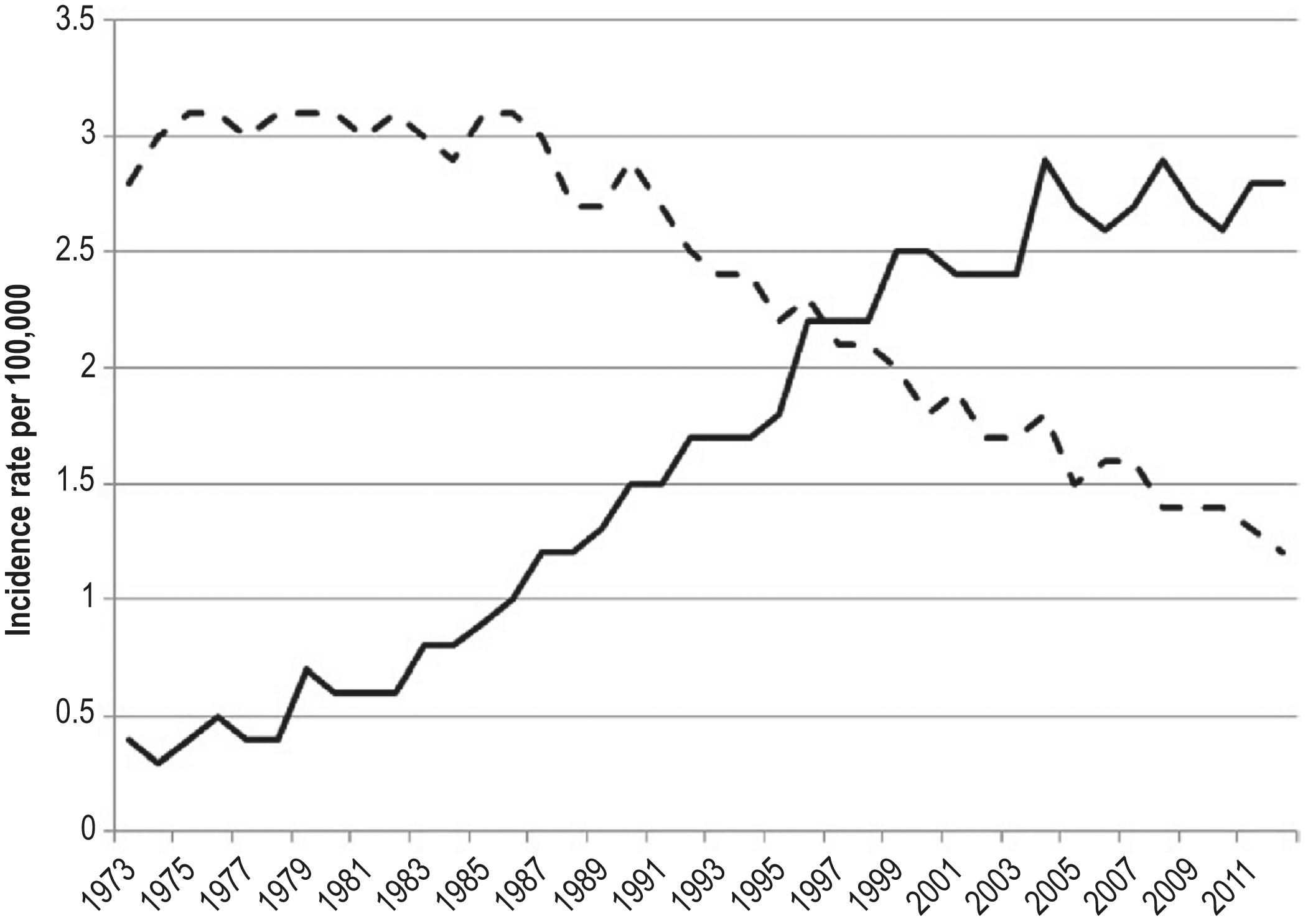
The aetiology of oesophageal cancer is multifactorial and strongly population-dependent. Low socioeconomic status, poverty, and poor oral hygiene have been linked to an increased risk of squamous cell cancer in particular ( Table 1.2 ). Foods containing N-Nitroso compounds are carcinogenic and have been implicated in the development of squamous cell cancer. Alcoholic beverages and other foods can contain or be metabolized to acetaldehyde, a class 1 carcinogen. Most epidemiological studies have confirmed alcoholic beverages as a risk factor for squamous cell cancer although the carcinogenic effects vary with the degree of consumption. There is no evidence to suggest that alcohol consumption increases the risk of oesophageal adenocarcinoma. Interestingly, increased body mass index has been associated with lower risk of squamous cell cancer but increased risk of adenocarcinoma; underlying biological mechanisms for these differences are not clear. The current evidence of an association between squamous cell carcinoma and HPV infection is still inconclusive.
![]() Patients with gastric atrophy seem to have two- to threefold increased risk of developing oesophageal squamous cell cancer and gastric cancer but decreased risk of developing oesophageal adenocarcinoma.
Patients with gastric atrophy seem to have two- to threefold increased risk of developing oesophageal squamous cell cancer and gastric cancer but decreased risk of developing oesophageal adenocarcinoma.
| Smoking | Alcohol | Dietary influences | Socioeconomic status | H. pylori | |
|---|---|---|---|---|---|
| SCC | ++ | ++ | ++ | ++ | − |
| Oesophageal/OGJ ACA | − | + | ++ | + | + |
| Gastric ACA | ++ | + | ++ | ++ | ++ |
Oesophageal squamous cell cancer and adenocarcinoma genetics are discussed in detail in Chapter 2.
Oesophageal squamous cell carcinoma development is believed to be a multistep process from normal squamous epithelium via intraepithelial neoplasia (synonym: dysplasia) to invasive carcinoma based on findings in high-risk populations where dysplasia predates the development of carcinoma by approximately 5 years. , Squamous cell dysplasia is generally asymptomatic and endoscopically only visible using topical Lugol iodine or advance imaging methods like narrow band imaging.
The histological diagnosis of dysplasia requires the presence of cytological (nuclear enlargement, pleomorphism, overlapping) and architectural atypia (abnormal epithelial maturation towards the surface). Squamous cell dysplasia is classified as ‘low-grade’ when architectural and cytological abnormalities are seen in the basal half of the squamous epithelium with preserved maturation of the upper half. High-grade squamous cell dysplasia is diagnosed when more than the bottom half shows architectural and cytological abnormalities. Note that high-grade squamous cell dysplasia includes the group of lesions classified as ‘carcinoma in situ’.
Large Chinese studies suggest that progression from squamous dysplasia to squamous cell cancer is relatively slow even in a high-risk population, offering ample opportunity for intervention.
Squamous cell carcinoma is per definition a neoplasm with squamous cell differentiation characterised by keratinocyte-like cells with intercellular bridges and/or keratinisation which at least penetrates the epithelial basement membrane into the lamina propria.
![]() The aetiology and predisposing factors for oesophageal squamous cell carcinoma vary significantly among different regions in the world. Tobacco-smoking, alcohol, and hot beverages such as hot mate tea are major risk factors for oesophageal squamous cell carcinoma. ,
The aetiology and predisposing factors for oesophageal squamous cell carcinoma vary significantly among different regions in the world. Tobacco-smoking, alcohol, and hot beverages such as hot mate tea are major risk factors for oesophageal squamous cell carcinoma. ,
Oesophageal squamous cell carcinomas are found in the upper, middle, and lower third of the oesophagus in a ratio of approximately 1:5:2. The native (untreated) macroscopic appearance of the tumour depends on the depth of tumour invasion and is classified into four different types according to the Japanese Esophageal Society, which is similar to the macroscopic classification of gastric cancer ( Fig. 1.2 ). Approximately 60% of squamous cell carcinomas show an exophytic or fungating growth pattern ( Fig. 1.3 ), 25% are ulcerative and 15% are infiltrative.
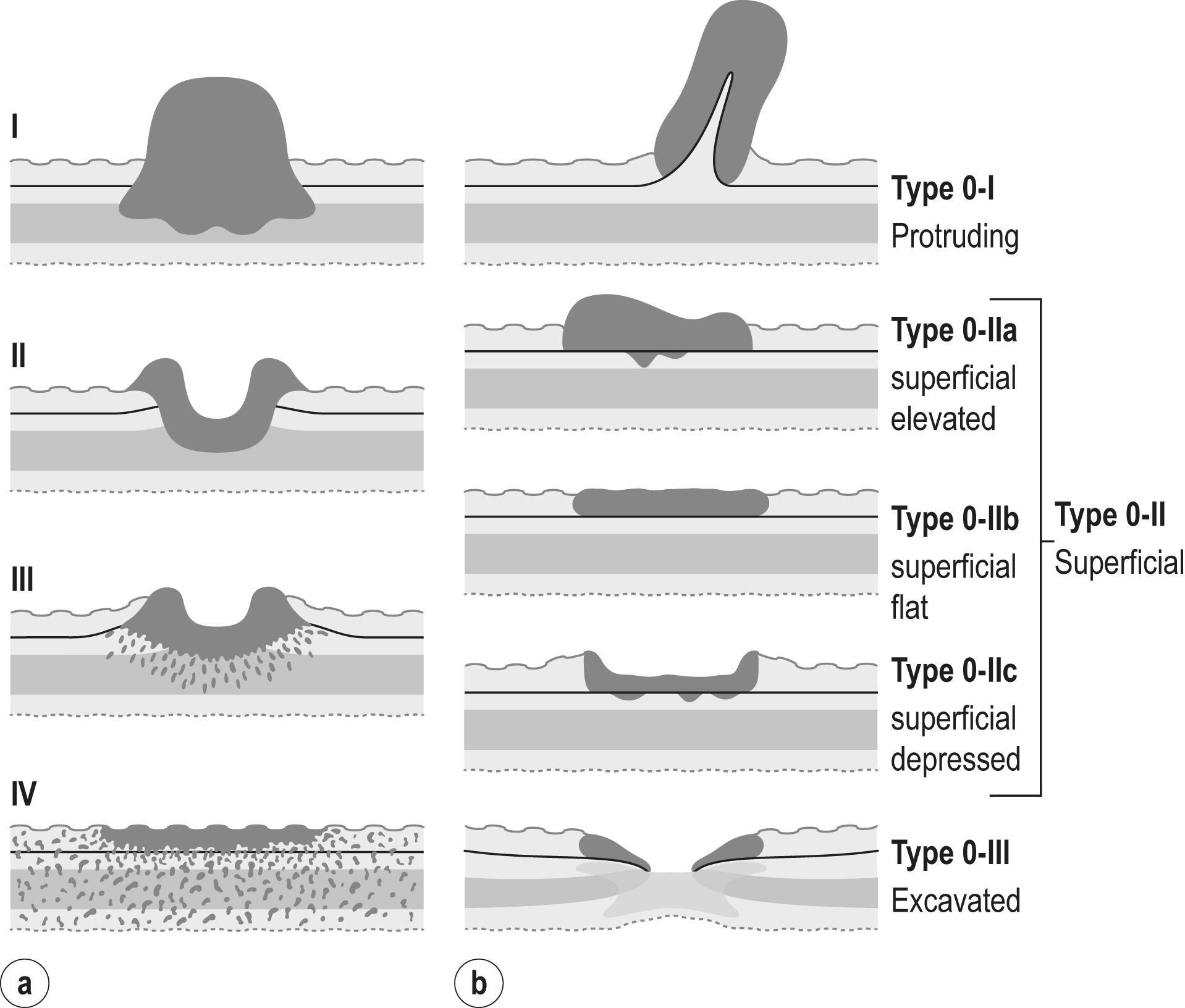
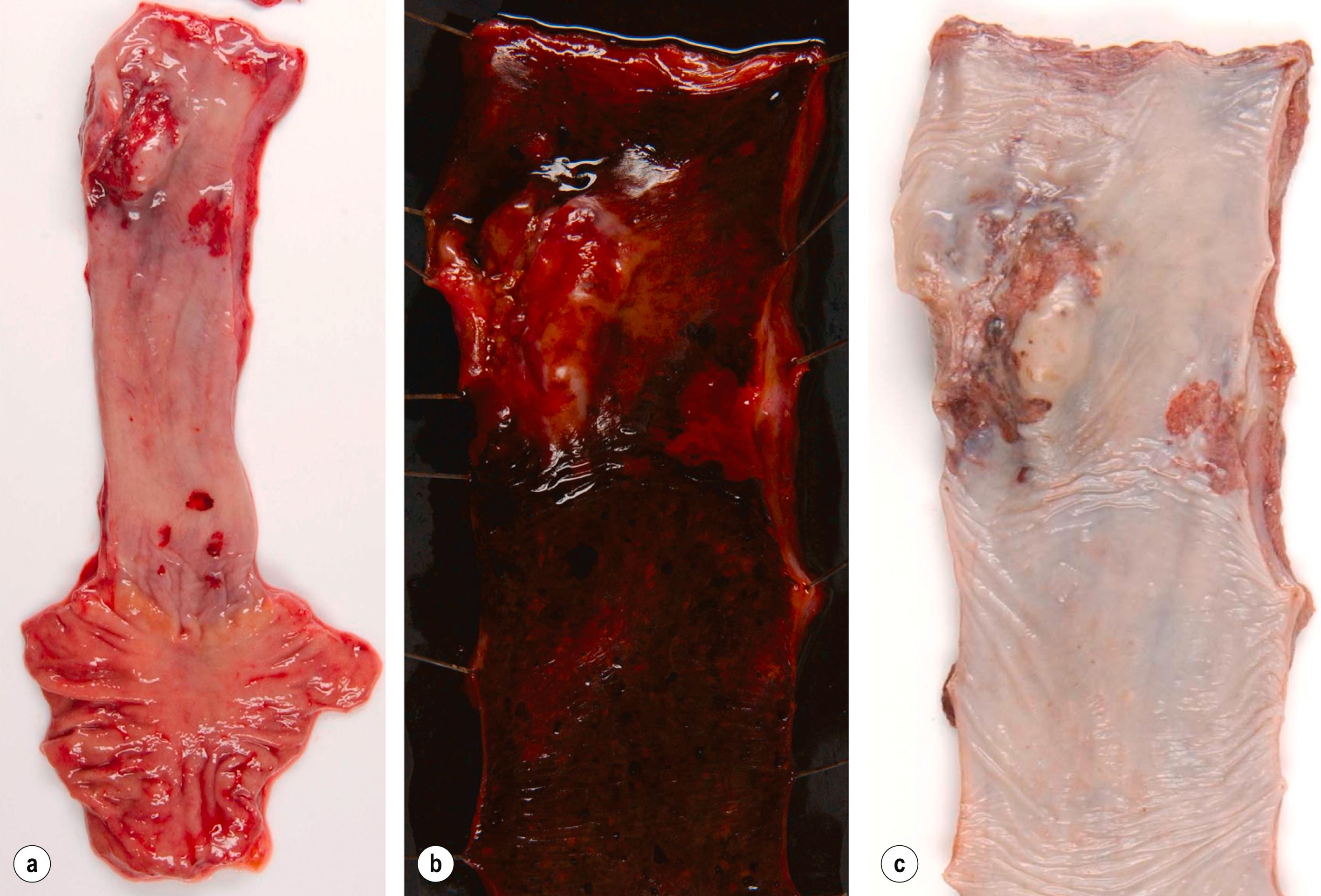
Squamous cell carcinomas can grow horizontally and vertically. In the West, 60% of patients have carcinomas that have invaded beyond the muscularis propria and have regional lymph node metastases at the time of diagnosis. In contrast, in Japan, up to 40% of all resected oesophageal carcinomas are superficial or early carcinomas involving mucosa and submucosa only. The frequency of lymph node metastases is related to the depth of tumour invasion in the wall (5% for carcinomas in the superficial submucosa [sm1 cancers] versus up to 55% for carcinomas in the deep submucosa [sm3 cancers]). Although tumours located in the upper third of the oesophagus are more likely to spread to cervical and upper mediastinal lymph nodes, a significant proportion will also spread to perigastric lymph nodes.
![]() Tumours located in the middle and lower oesophagus can spread to upper mediastinal as well as perigastric nodes and patients with lymph node metastases on both sides of the diaphragm have been shown to have a poorer prognosis.
Tumours located in the middle and lower oesophagus can spread to upper mediastinal as well as perigastric nodes and patients with lymph node metastases on both sides of the diaphragm have been shown to have a poorer prognosis.
Distant metastases due to haematogenous spread are most commonly found in liver, lung, adrenal gland and kidney.
Histologically, squamous cell carcinomas are characterised by keratinocyte-like cells, which show a variable degree of keratinisation. Depending on the extent of mitotic activity, nuclear atypia, and degree of squamous differentiation including degree of keratinisation, squamous cell carcinomas are graded as well, moderately, or poorly differentiated ( Fig. 1.4 ).
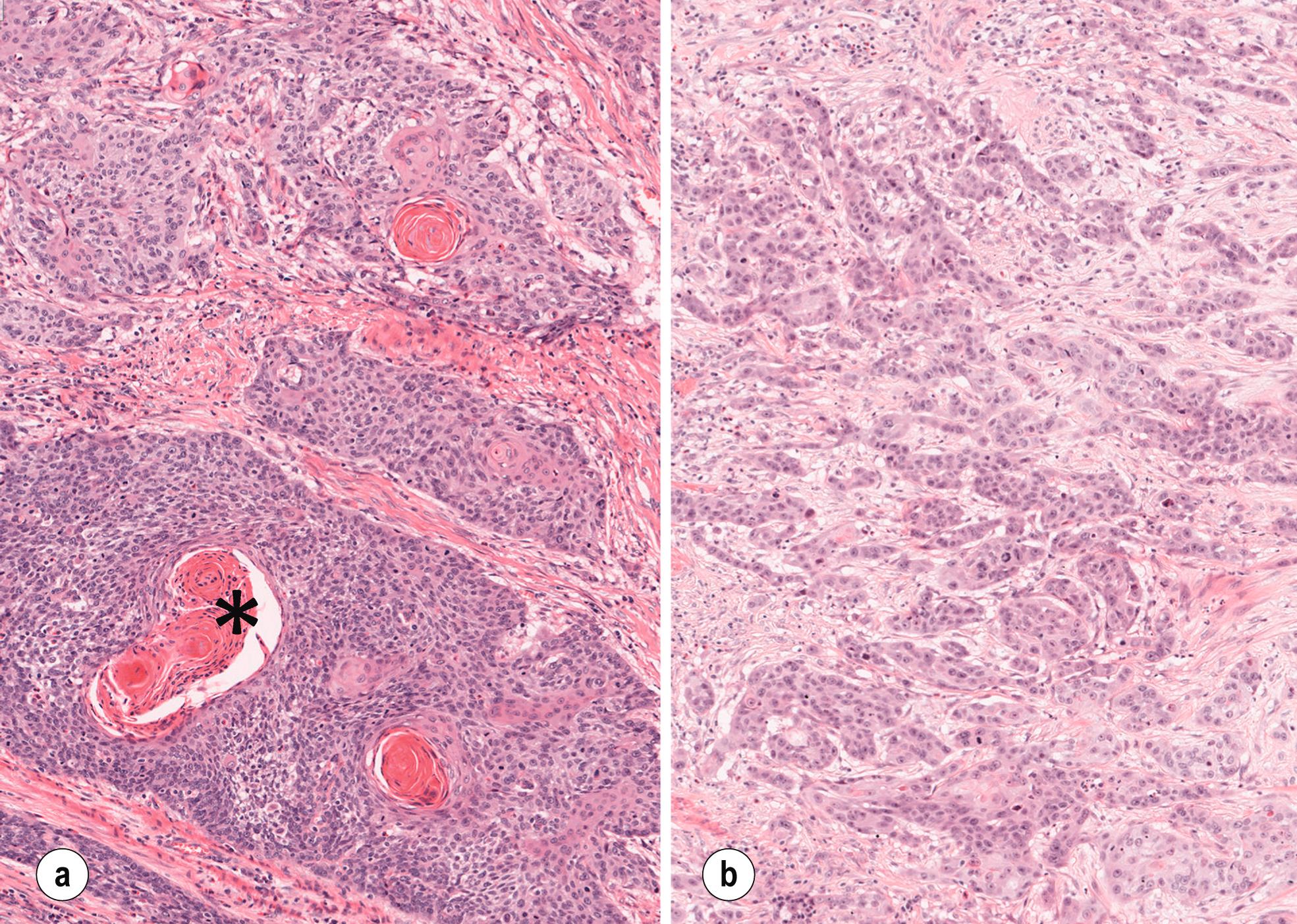
Three main variants of squamous cell carcinoma have been described:
Verrucous carcinoma of the oesophagus is a rare, slow-growing, locally aggressive tumour, which is more common in males and arises in the setting of chronic mucosal injury. Macroscopically, the tumour has an exophytic papillary appearance and is most frequently located in the lower third of the oesophagus. Tumours are usually very large before they become clinically apparent. Microscopically, the tumour is very well differentiated with minimal atypia. Superficial endoscopic biopsies can be insufficient to distinguish between a squamous papilloma, pseudoepitheliomatous hyperplasia, and verrucous carcinoma.
Spindle cell squamous cell carcinoma (also known as carcinosarcoma, sarcomatoid carcinoma, and metaplastic carcinoma) is a polypoid tumour located in the middle or lower third of the oesophagus. Histologically, the tumour is biphasic with an epithelial element (well to moderately differentiated squamous cell carcinoma) and a spindle cell component, which is usually of high grade and can show osseous, cartilaginous, or skeletal muscle differentiation. Spindle cell carcinomas are highly aggressive carcinomas with 5-year survival rates of 10–15%.
Basaloid squamous cell carcinoma accounts for approximately 5% of all oesophageal cancers and needs to be distinguished from ‘pure’ squamous cell carcinoma, adenoid cystic carcinoma, and neuroendocrine tumours using appropriate immunohistochemical marker. It is a highly aggressive carcinoma with a very poor prognosis. Histologically, this tumour shows the characteristic basaloid cells together with a mucoid hyaline-like PAS positive substance ( Fig. 1.5 ).
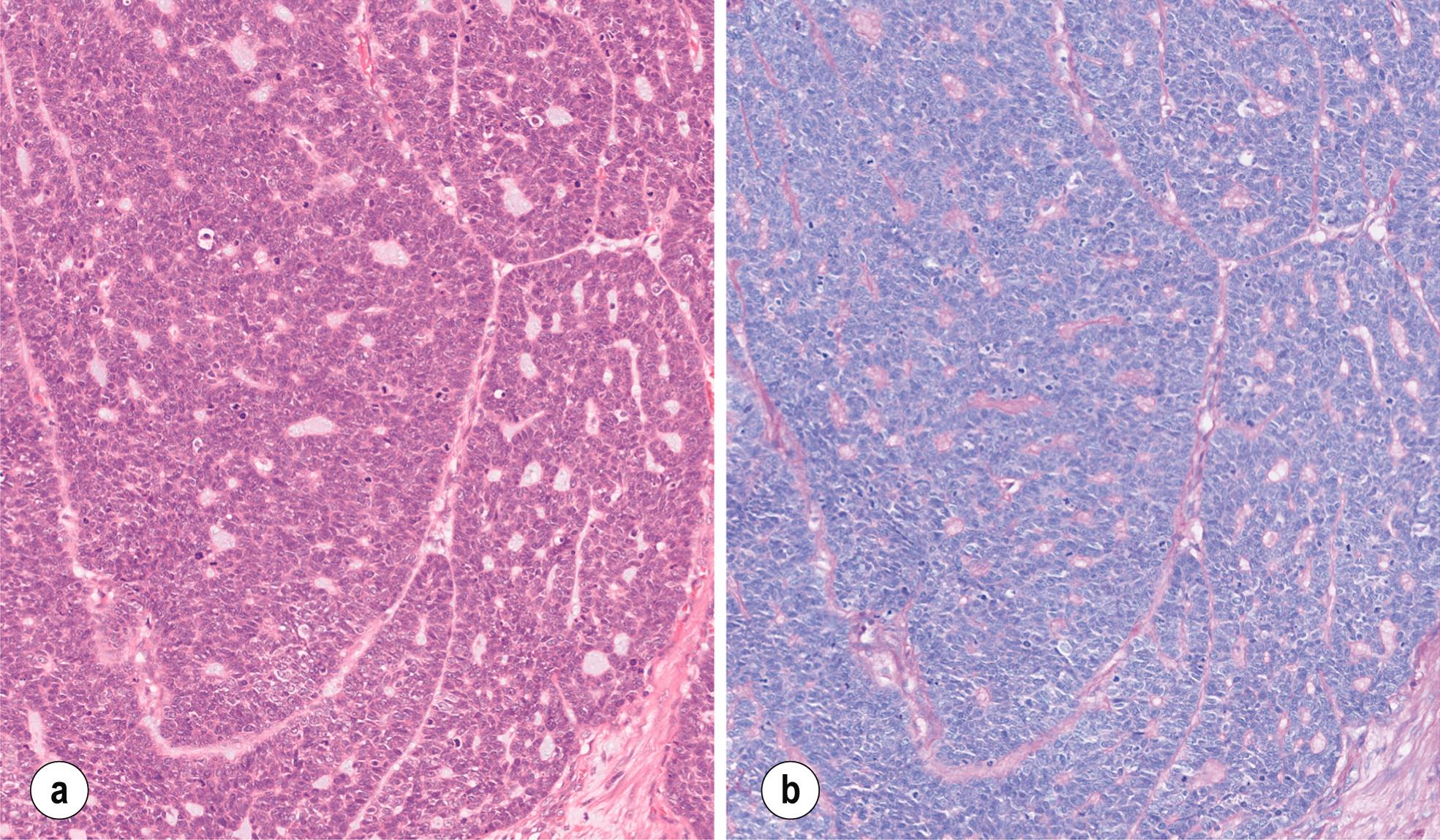
It can be difficult to distinguish between poorly differentiated squamous cell carcinomas and poorly differentiated adenocarcinoma based on the routine haematoxylin/eosin stained tissue section alone. In this context, an immunohistochemical marker panel is used in routine clinical practice to establish the diagnosis. Squamous cell cancers are usually immunopositive for CK5/6, CK14, p63, or p40 and negative for CK7, CK20, and CDX2.
To date, there are no molecular markers established in routine clinical practice in patients with squamous cell carcinoma to predict prognosis or response to chemotherapy. However, in the research setting, a number of genomic changes have been described which are discussed in more detail in Chapter 2.
Adenocarcinoma is histologically defined as a malignant epithelial tumour with glandular and/or mucinous differentiation that has at least infiltrated into the lamina propria.
The normal oesophagus is lined with squamous epithelium with a sharp transition to gastric cardia-type mucosa at the Z line. Moersch et al. and Hayward were the first to suggest that the columnar lining of the oesophagus might be an acquired condition/adaptive response to recurrent injury of the squamous mucosa due to gastro-oesophageal reflux. In response to the damaging effect of reflux, the squamous epithelium changes to a non-goblet columnar epithelium similar to gastric cardia type epithelium. Over time, this newly formed epithelium can differentiate into parietal and chief cells or develop goblet cells and Paneth cells. Barrett’s oesophagus is defined as presence of metaplastic columnar epithelium in the oesophagus and is considered a precancerous lesion. For a histological illustration of Barrett’s oesophagus, see Fig. 1.6 .
![]() Barrett’s oesophagus is defined as an oesophagus in which any portion of the normal distal squamous lining has been replaced by metaplastic columnar epithelium, which is clearly visible endoscopically above the gastro-oesophageal junction and confirmed histopathologically. In the UK, presence of intestinal metaplasia is considered highly corroborative but not specific for a diagnosis of Barrett’s oesophagus. Ninety-five per cent of oesophageal adenocarcinomas are associated with Barrett’s oesophagus, which has been identified as the single most important risk factor.
Barrett’s oesophagus is defined as an oesophagus in which any portion of the normal distal squamous lining has been replaced by metaplastic columnar epithelium, which is clearly visible endoscopically above the gastro-oesophageal junction and confirmed histopathologically. In the UK, presence of intestinal metaplasia is considered highly corroborative but not specific for a diagnosis of Barrett’s oesophagus. Ninety-five per cent of oesophageal adenocarcinomas are associated with Barrett’s oesophagus, which has been identified as the single most important risk factor.
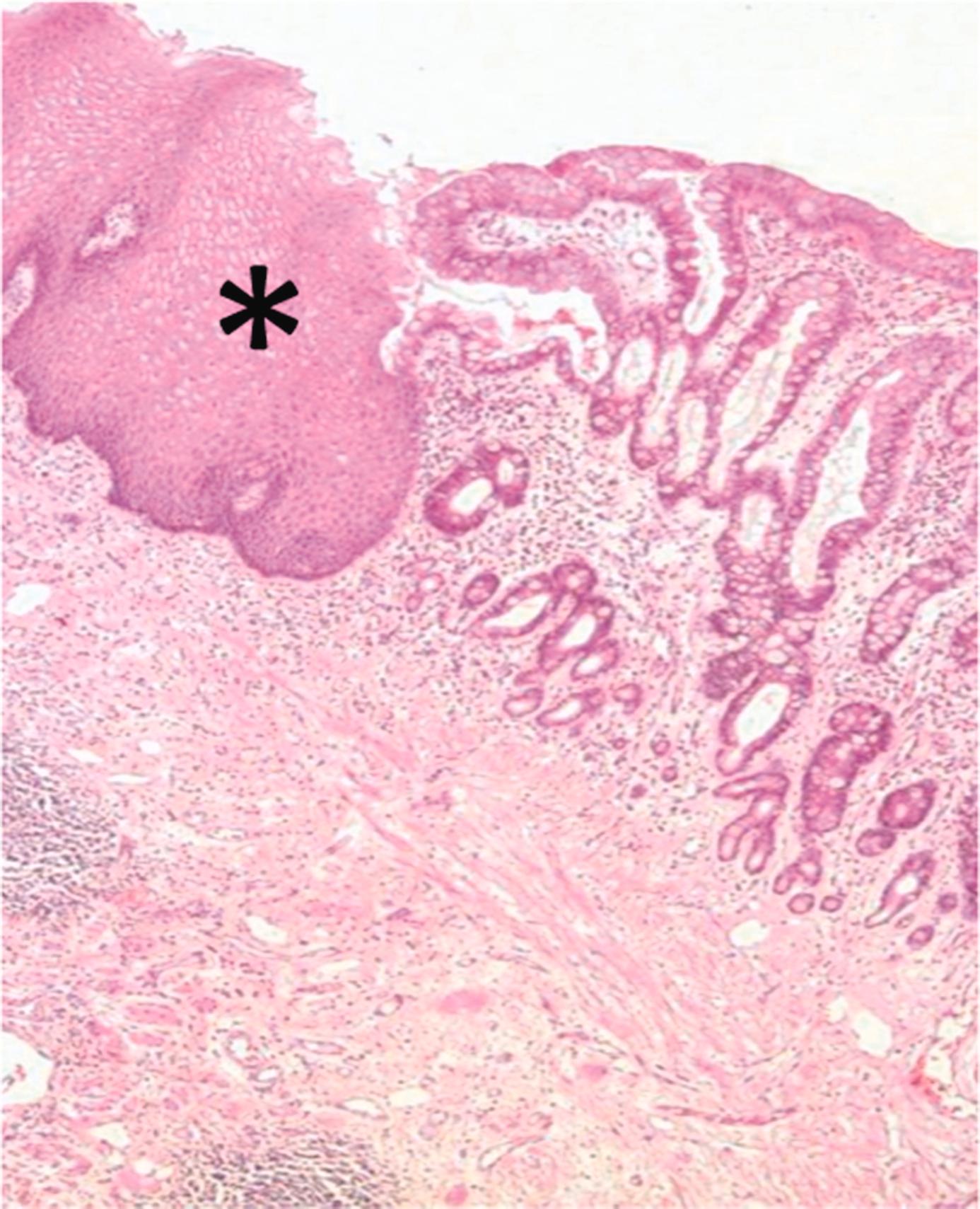
Further details about Barrett’s oesophagus, including the proposed metaplasia–dysplasia–adenocarcinoma sequence and molecular pathology findings, can be found in Chapter 2.
Barrett’s oesophagus-associated adenocarcinomas are located almost exclusively in the distal third of the oesophagus and often infiltrate into the proximal stomach ( Fig. 1.7 ). The macroscopic appearances of a locally advanced adenocarcinoma are similar to that of squamous cell carcinoma or gastric adenocarcinoma (see Fig. 1.2 ). Histologically, oesophageal adenocarcinoma can be classified as having tubular, papillary, mucinous, or signet-ring cell patterns and are graded as well, moderately, or poorly differentiated according to the proportion of tumour that is composed of glands (see also gastric adenocarcinoma). Approximately 10% of all oesophageal adenocarcinomas are of mucinous or signet-ring cell type.
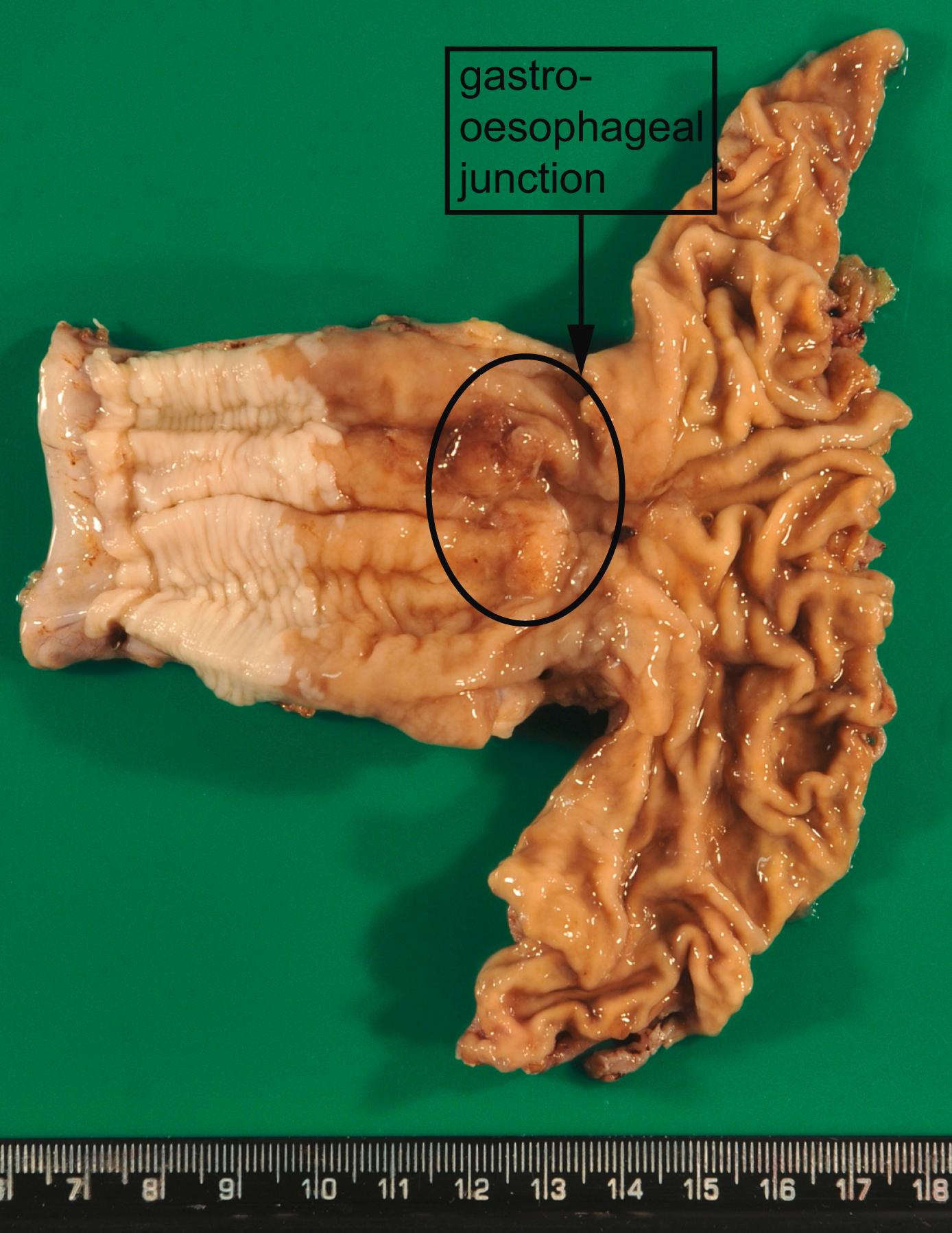
Most patients present with locally advanced disease, e.g. tumour extension into the peri-oesophageal fat and involvement of regional lymph nodes. Should a patient present with early disease, it is important to remember that a duplication of the muscularis mucosae can be seen in many cases with Barrett’s oesophagus. Carcinomas infiltrating between the two layers of the muscularis mucosae are still classified as ‘intramucosal’ (pT1a) cancers. However, carcinomas that have infiltrated into the double muscularis mucosae have been associated with a higher frequency of lymphoangioinvasion and lymph node metastases.
There is an ongoing debate whether adenocarcinoma in the proximity of the oesophagogastric junction should be classified as oesophageal or gastric carcinoma, as both disease entities are currently treated with different multimodal therapy approaches. One problem is the lack of worldwide consensus on the definition of the ‘gastro-oesophageal junction’ (see WHO classification of digestive cancer, 4e, 2010). The British Society of Gastroenterology guideline on the diagnosis and management of Barrett’s oesophagus recommends using the distal end of the palisade vessels or the proximal end of the gastric folds to identify the gastro-oesophageal junction.
Siewert et al. defined different types of adenocarcinoma of the gastro-oesophageal junction based on the location of the ‘tumour epicentre’ by combining clinical preoperative findings (radiology, endoscopy) with intra- and postoperative observations:
Type I: Adenocarcinoma of the distal oesophagus, which may infiltrate the gastro-oesophageal junction from above. This entity is also referred to as ‘Barrett’s oesophagus’. These adenocarcinomas have their centre within 1 cm to 5 cm above the anatomic gastro-oesophageal junction.
Type II: ‘True carcinoma of the cardia’ arising from gastric cardia epithelium or from short segments of metaplastic columnar epithelium at the gastro-oesophageal junction. This entity is also referred to as ‘junctional carcinoma’. These adenocarcinomas have their centre within 1 cm above and 2 cm below the anatomic gastro-oesophageal junction.
Type III: Subcardial gastric carcinoma, which infiltrates the oesophagogastric junction and distal oesophagus from below. This entity is also referred to as ‘proximal gastric carcinoma’. These adenocarcinomas have their centre within 2 cm and 5 cm below the anatomic gastro-oesophageal junction.
The TNM classification which is routinely used to stage cancers does not recognize cancers involving the gastro-oesophageal junction as own entity. In the current TNM classification (8th ed.), cancers in this location are classified either as oesophageal (epicentre located within the proximal 2 cm of the cardia) or as gastric (epicentre located within the distal 2 cm of the cardia) cancer.
Adenoid cystic carcinoma is very rare (0.1% of all oesophageal malignancies). These carcinomas are histologically identical to salivary gland-type adenoid cystic carcinoma and occur more frequently in males. These cancers are located in the middle third of the oesophagus and thought to arise from submucosal oesophageal glands and usually form well-circumscribed solid nodules in the submucosa with the overlying squamous epithelium showing no abnormality. Histologically, these tumours show glandular differentiation with epithelial and myoepithelial cells in true glandular and pseudoglandular lumina arranged in cribriform, tubular, or solid architecture.
Adenosquamous carcinoma/mucoepidermoid carcinoma is equally rare. They are located in the middle and lower oesophagus and are more frequent in males. Histologically they show an admixture of adenocarcinoma and squamous cell carcinoma. Some studies suggest that these cancers are more aggressive than conventional squamous cell carcinomas.
Neuroendocrine neoplasms (NEN) are epithelial neoplasms with neuroendocrine differentiation and include well-differentiated neuroendocrine tumours (NETs), poorly differentiated neuroendocrine carcinomas (NEC, small cell type versus large cell type), and mixed neuroendocrine-non-neuroendocrine neoplasms (MiNENs). Neuroendocrine differentiation needs to be confirmed by immunohistochemistry for synaptophysin and chromogranin A. Furthermore Ki67 immunohistochemistry is required to establish the proliferation index for grading (Ki67 index <3% = low grade (G1); 3–20% = intermediate grade (G2), >20% high grade (G3)).
Oesophageal NENs are exceedingly rare (<1% of all gastroenteropancreatic NENs), more frequent in males and mostly located in the distal oesophagus. The majority of oesophageal NENs are poorly differentiated neuroendocrine (small cell) carcinomas, which are highly aggressive with a median survival of 6–12 months or less. Histologically, these may appear as homogeneous tumours ( Fig. 1.8 ) or consist of a mixture of squamous and mucoepidermoid elements. The main differential diagnosis of oesophageal small cell NECs are basaloid squamous cell carcinoma and metastasis of small cell carcinoma of the lung.
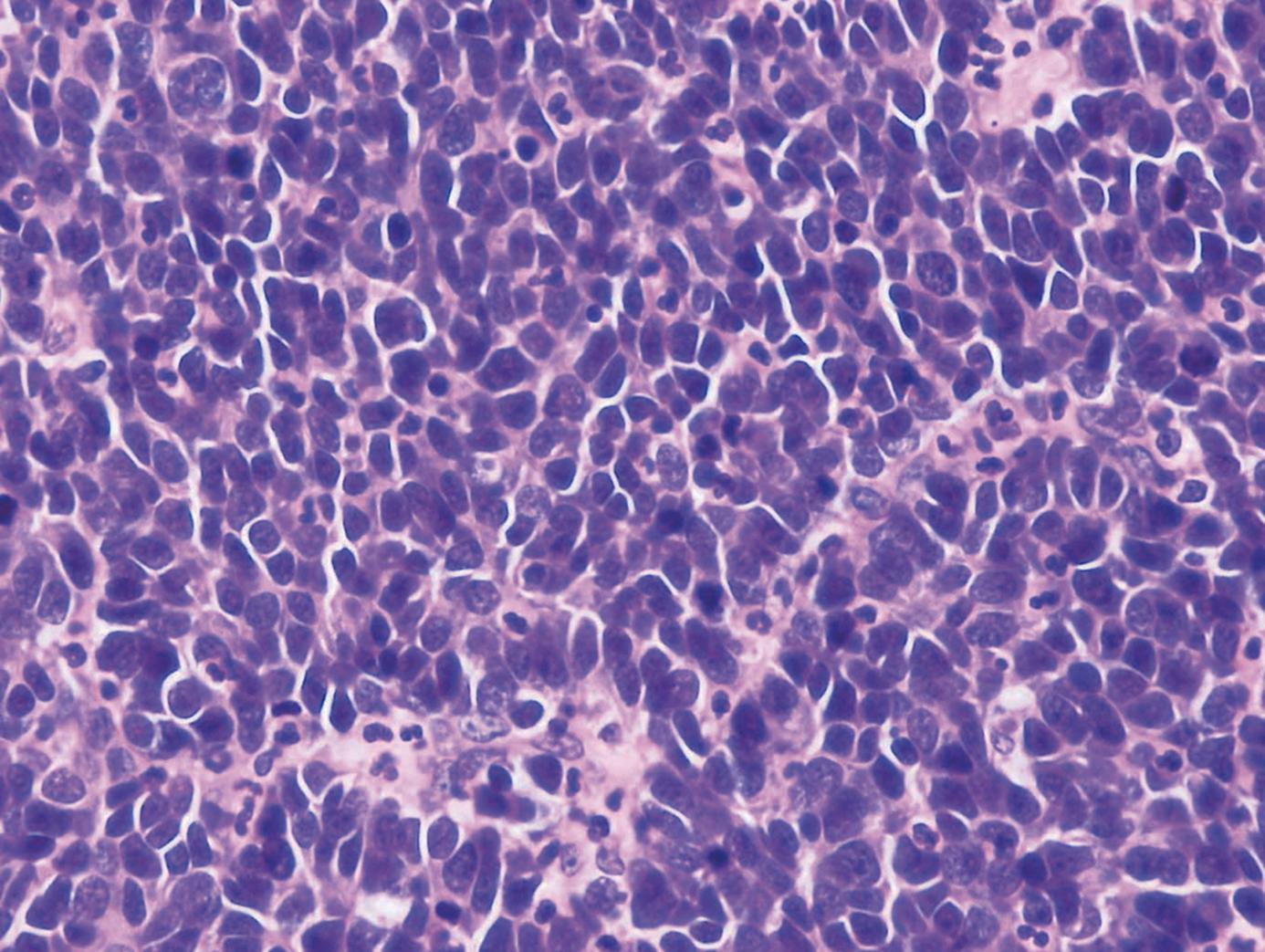
Become a Clinical Tree membership for Full access and enjoy Unlimited articles
If you are a member. Log in here